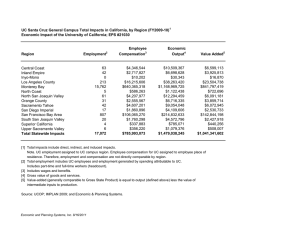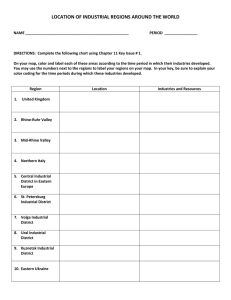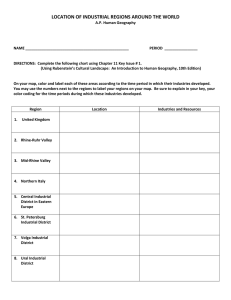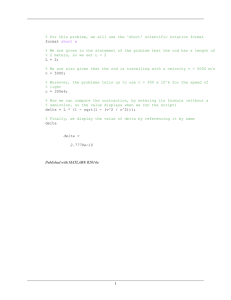Adaptations for Hydroclimate Variability: Revising Water Year Classification in Non-stationary Climates
advertisement
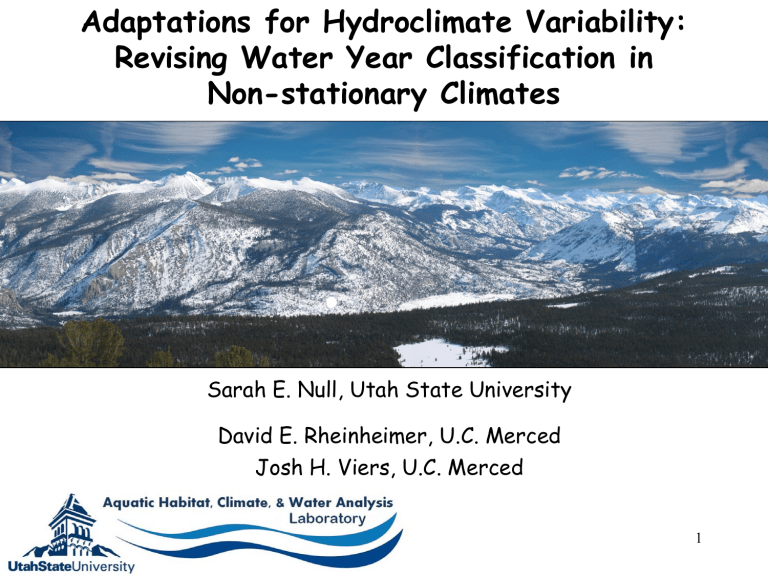
Adaptations for Hydroclimate Variability: Revising Water Year Classification in Non-stationary Climates Sarah E. Null, Utah State University David E. Rheinheimer, U.C. Merced Josh H. Viers, U.C. Merced 1 September 9, 2014 2 3 4 Water Year Indices Simplify Complex Hydrology Unimpaired precipitation/runoff compared to historical averages Single, numerical metric Threshold-based Is there ‘enough’ water Framework for water allocations Tied to water resource management Used in rule-based decisionmaking Examples: Palmer Drought Severity Index Standard Precipitation Index Surface Water Supply Index Reclamation Drought Index Deciles Study Indices: Sacramento Valley Index (SVI) San Joaquin Valley Index (SJI) Yuba River Index 5 Research Questions How will anticipated hydroclimatic changes affect water allocation? How will stationary water management frameworks function with climate change? 6 Climate change is altering California’s hydrology Precipitation shifting from snowfall to rainfall Snowpack stores water Earlier runoff More winter flooding More summer drought California’s Sacramento-San Joaquin Bay Delta ~ 43% of CA’s average annual surface runoff 8 Who Depends on the Sacramento and San Joaquin Valley Indices? Delta smelt (endangered) Banks Pumping Plant (SWP) Water Supply CVP and SWP pumps Source of drinking water for ~ 24 million Californians Agricultural water Delta islands Delta Farmers Farming on Delta islands Consumptive uses Environment Bay-Delta outflow Salinity and water temperature objectives River instream flows 9 Drive water policy Sacramento and San Joaquin Valley Indices SVI = (0.4*current Apr-Jul runoff) + (0.3*current Oct-Mar runoff) + (0.3*previous year’s index) SJI = (0.6*current Apr-Jul runoff) + (0.2*current Oct-Mar runoff) + (0.2*previous year’s index) Historical Water Year Type Thresholds Water Year Type Sacramento Valley Index (maf) San Joaquin Valley Index (maf) ≥9.2 ≥3.8 Above Normal >7.8 and <9.2 >3.1 and <3.8 Below Normal >6.5 and ≤7.8 >2.5 and ≤3.1 Dry >5.4 and ≤6.5 >2.1 and ≤2.5 ≤5.4 ≤2.1 Wet Critical 10 Historical Water Year Type Distribution 1905-2000 11 Methods – multiple model, multiple emissions scenario approach Long-term (2051-2099) Near-term (2001-2050) Time Periods Historical (1951-2000) CNRM CM3 GFDL CM2.1 SRESA2 CCSR MIROC 3.2 medium Emissions GCMs SRESB1 MPI-OM ECHAM5 SVI VIC WYTs SJI NCAR CCSM3.0 NCAR PCM1 12 Percentage of Years 60 50 40 30 20 10 0 Percentage of Years Critical 60 50 40 30 20 10 0 Percentage of Years Dry Below Normal Above Normal Wet Dry Below Normal Above Normal Wet Dry Below Normal Above Normal Wet - more even distribution of year types b) 2001-2050 Critical 60 50 40 30 20 10 0 Relative Frequency of Sacramento Valley Water Years a) 1951-2000 c) 2051-2099 Critical 13 Percentage of Years 90 80 70 60 50 40 30 20 10 0 a) 1951-2000 Percentage of Years Critical Below Normal 90 80 70 60 50 40 30 20 10 0 Above Normal Wet - distribution skewed toward dry year types b) 2001-2050 Critical Percentage of Years Dry Relative Frequency of San Joaquin Valley Water Years Dry Below Normal 90 80 70 60 50 40 30 20 10 0 Above Normal Wet c) 2051-2099 Critical Dry Below Normal Above Normal Wet 14 Distribution of Water Year Types Changes if Historical Thresholds Held Constant Sacramento Valley San Joaquin Valley 15 Null and Viers. 2013. Water Resources Research Water Year Classification Thresholds Reduced to Maintain Historical Distribution of Water Years Sacramento Valley San Joaquin Valley Null and Viers. 2013. Water Resources Research Water Allocations Vary by Year Type Wet Above Normal, Below Normal Dry, Critical (%) (%) (%) Delta Farming 3 7 12 Water Supply 10 27 37 Environmental Uses 87 69 51 (Bay Delta Conservation Plan, 2010) 17 Climate Change Affects Water Allocations Environmental Uses Water Exports Delta Farming Average Annual Water Deliveries (2051-2099) Water Supply (pumped exports) Delta Farming Environmental (consumptive uses) (incl. undev. water) (taf) (taf) (taf) Hist. Thresholds +70 +49 -3135 Hist. Distribution -124 -31 -2861 4,484 1,386 17,20318 Average Annual Delivery taf= thousands of acre-feet Example Bay-Delta water balance for 2051-2099 Average annual water allocation for Delta outflow, exports, and consumptive use (taf) Average annual change (from historical) in bold values (taf) Black bars quantify uncertainty between A2 & B1 Arrow & bar length represent flow percentage Upper Yuba River 20 Yuba Watershed 2 cfs 1200 mi2 22 dams (> 1 taf) 1.43 maf surface storage 12 hydropower facilities 2-3 cfs 424 MW online capacity 5 cfs 20 Instream Flow Requirement (ft3/s) Proposed instream flows by water year type 90 80 70 60 50 40 30 20 10 0 ECD CD D BN AN W 21 Modeling methods Monthly optimization model: A 12-month multi-reservoir linear programming model run each month Hydropower flows, Instream flows, Spill Inflows from a hydrology model using downscaled climate projections 4 time periods (historical, near term, mid-term, far term) Eight downscaled projections: WCRP CMIP5 Climate Model (GCM) ID End-of-century precipitation MIROC-ESM Drier MIROC5 CCSM4 CNRM-CM5 Slightly drier Slightly wetter Wetter RCP 4.5 Projection Name miroc-esm.1.rcp45 8.5 miroc-esm.1.rcp85 4.5 miroc5.1.rcp45 8.5 miroc5.1.rcp85 4.5 ccsm4.1.rcp45 8.5 ccsm4.1.rcp85 4.5 cnrm-cm5.1.rcp45 8.5 cnrm-cm5.1.rcp85 22 Preliminary Results – Water allocation by use Hist. Nearterm Midterm Farterm 23 Rheinheimer, Null, Viers. In Prep. Water Year Type Alternatives Assumptions about hydrologic stationarity matter in both modeling and real-world decision making. Climate change adaptation will likely require alternative WYT-based allocation schemes. HP HP W N D HP Env. Env. HP W N D Env. W N D Env. WYT 24 Rheinheimer, Null, Viers. In Prep. Major Findings Current classifications less representative with climate change SVI: 34-38% dry & critical years by 2051-2099 SJI: 66-69% dry & critical years by 2051-2099 Climate change adaptations affect allocations as much as impacts Burden of climate change to different users Other adaptation options: Change seasonal weights in indices Change carryover storage weight Many regulatory processes assume climate stationarity 25 Questions? Contact Info: Sarah Null (sarah.null@usu.edu) Climate Data: Climate Research Division of Scripps Institute for Oceanography (Dan Cayan & Mary Tyree) Funding: California Energy Commission 26
